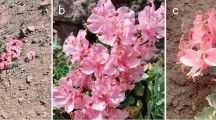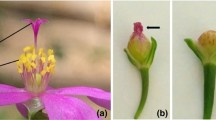Abstract
InBulbophyllum involutum andB. ipanemense (Orchidaceae), two closely related species, shortly after removal the pollinarium has a diameter of approximately twice that of the entrance of the stigmatic cavity, requiring a mean time of 105 to 135 minutes to shrink in width and allow pollination. Because the pollinators of these species remain for some minutes in the same flower after removing the pollinia this mechanism, previously unknown inOrchidaceae, may be very important in preventing self-pollination. This mechanism does not occur inB. weddellii, and the pollinator does not remain in the flower after removing the pollinia. The smaller diameter of the stigmatic cavity inB. involutum reduces by 50% the chances of interspecific pollination withB. weddellii, and interspecific crossing is strictly unidirectional. This is important in maintaining isolation between these sympatric species, which share the same pollinators and have synchronized flowering.
Similar content being viewed by others
References
Ackerman J. D., Mesler M. R. (1979) Pollination biology ofListera cordata (Orchidaceae). Amer. J. Bot. 66: 820–824.
Adams R. M., Goss G. J. (1976) The reproductive biology of the epiphytic orchids of Florida III.Epidendrum anceps Jacq. Amer. Orchid Soc. Bull. 45: 488–492.
Borba E. L., Semir J. (1998b)Bulbophyllum ×cipoense (Orchidaceae), a new natural hybrid from the Brazilian ‘campos rupestres’: description and biology. Lindleyana 13: 113–120.
Borba E. L., Semir J. (1998a) Wind-assisted fly pollination in threeBulbophyllum (Orchidaceae) species occurring in Brazilian “campos rupestres”. Lindleyana 13: 203–218.
Borba E. L., Shepherd G. J., Semir J. (1999) Reproductive systems and crossing potential in three species ofBulbophyllum (Orchidaceae) occurring in Brazilian ‘campos rupestres’ vegetation. Plant Syst. Evol. 217: 205–214.
Braga P. I. S. (1977) Aspectos biológicos dasOrchidaceae de uma campina na Amazônia Central. Acta Amazônica 7/2 [Suppl.]: 1–89.
Catling P. M. (1990) Auto-pollination inOrchidaceae. In: Arditti J. (ed.) Orchid biology, reviews and perspectives, 5. Timber Press, Portland, pp. 121–158.
Catling P. M., Catling V. R. (1991) Anther-cap retention inTipularia discolor. Lindleyana 6: 113–116.
Chase M. W. (1985) Pollination ofPleurothallis endotrachys. Amer. Orchid. Soc. Bull. 54: 431–434.
Christensen D. E. (1992) Notes on the reproductive biology ofStelis argentata Lindl. (Orchidaceae: Pleurothallidinae) in eastern Ecuador. Lindleyana 7: 28–33.
Dodson C. H., Frymire G. P. (1961) Natural pollination of orchids. Missouri Bot. Gard. Bull. 49: 133–139.
Dressler R. L. (1981) The orchids: natural history and classification. Harvard University Press, Cambridge.
Dressler R. L. (1993) Phylogeny and classification of the orchid family. Cambridge University Press, Cambridge.
Jones D. L., Gray B. (1976) The pollination ofBulbophyllum longiflorum Thouars. Amer. Orchid. Soc. Bull. 45: 15–17.
Meve U., Liede S. (1994) Floral biology and pollination in stapeliads — new results and a literature review. Plant Syst. Evol. 192: 99–116.
Montalvo A. M., Ackerman J. D. (1987) Limitations to fruit production inIonopsis utricularioides (Orchidaceae). Biotropica 19: 24–31.
Pedersen H. A. (1995) Anthecological observations onDendrochilum longibracteatum — a species pollinated by facultatively anthophilous insects. Lindleyana 10: 19–28.
Pijl L. van der, Dodson C. H. (1966) Orchid flowers: their pollination and evolution. University of Miami Press, Coral Gables.
Proctor M., Yeo P., Lack A. (1996) The natural history of pollination. Harper Collins, London.
Ridley H. N. (1890) On the method of fertilization inBulbophyllum macranthum, and allied orchids. Ann. Bot. 4: 327–336.
Schemske D. W. (1980) Evolution of floral display in the orchidBrassavola nodosa. Evolution 34: 489–493.
Stoutamire W. (1978) Pollination ofTipularia discolor, an orchid with modified symmetry. Amer. Orchid Soc. Bull. 47: 413–415.
Tremblay R. L. (1992) Trends in the pollination ecology of theOrchidaceae: evolution and systematics. Canad. J. Bot. 70: 642–650.
Zar J. H. (1984) Biostatistical analysis, 2nd edn. Prentice-Hall, Englewood Cliffs.
Zimmerman J. K., Aide T. M. (1989) Patterns of fruit production in a neotropical orchid: pollinator vs. resource limitation. Amer. J. Bot. 76: 67–73.
Author information
Authors and Affiliations
Rights and permissions
About this article
Cite this article
Borba, E.L., Semir, J. Temporal variation in pollinarium size after its removal in species of Bulbophyllum: A different mechanism preventing self-pollination in Orchidaceae. Pl Syst Evol 217, 197–204 (1999). https://doi.org/10.1007/BF00984365
Received:
Accepted:
Issue Date:
DOI: https://doi.org/10.1007/BF00984365




